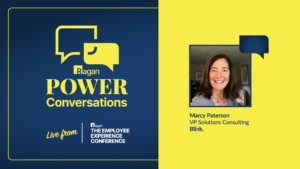Employee engagement tips from the C-suite
Culture alignment drives productivity, and productivity drives business.

Culture alignment drives productivity, and productivity drives business. This is why employee engagement starts from the top.
During Ragan’s Employee Experience Conference in Nashville last August, Ragan Editorial Director and Editor-in-Chief Justin Joffe asked Pacific Northwest National Laboratory (PNNL) CCO Amanda Schoch, Exos CPO Greg Hill, Tennessee State Government CCO Karl Houston and Southwire CPO Fernando Esquivel how they solve employee disengagement.
Here’s what we learned.
- Share a values-driven leadership philosophy
The panelists began by emphasizing the importance of communicating clear values and philosophies to guide employee engagement strategies during times of change. Making it simple helps it resonate with managers and their reports alike.
Southwire uses the “four Cs” – communication, collaboration, connection, and celebration – as guiding principles for employee engagement. These pillars are reiterated frequently to keep employees aligned with the company’s mission. “How are we connecting, communicating, collaborating, and celebrating?” asked Esquivel We have to make these part of the equation.”
Transparency, humility, and continuous improvement are the three core values at Exos, which play a critical role in how the organization handles change and communicates with employees. “We admit when we did something wrong and pivot,” said Hill. “Transparency in failure leads to greater engagement.”
PNNL’s comms team sees themselves as “sense makers” who distill complex information and guide employees through change. “We are the integrators for all the touchpoints that hit our staff, helping employees feel more connected to the organization,” said Schoch.
- Manage uncertainty with clarity
Each leader emphasized the importance of clear and continuous communication as the foundation for successful change management, especially in uncertain times.
Houston urged communicators to focus on both the technical and human aspects of change. While project management is essential to processing, the real challenge is ensuring that people adapt. “Organizations don’t change unless people change,” he said.
Exos adopts a “pilot” mindset, where initiatives are tested, evaluated, and iterated upon. This provides flexibility and room for mistakes during periods of change. “We use the word ‘pilot’ to give permission to make mistakes and try new things,” explained Hill.
During the pandemic, Southwire implemented a “people and lives” approach, focusing on employee well-being while keeping business goals in sight. Regular CEO video updates kept employees informed and engaged throughout this period.
“Our CEO produced weekly videos for three and a half years to connect with 9,000 employees, even when the message was, ‘We don’t know, but we’ll update you next week,’” Esquivel said.
PNNL uses employee ambassadors to communicate during change, sharing key information with employees and serving as a feedback loop to the leadership team.
“They’re not just cheerleaders – they tell us what’s resonating and when something isn’t holding up in the real world,” said Schoch.
- Data-driven decisions guide change
The panelists also stressed the importance of deploying data to make informed decisions during transitions.
Exos partnered with Wharton to develop a “Readiness Index” for measuring employee engagement and even thriving, which then informed their change management process. This data-driven approach allowed Exos to measure the impact of change on both business metrics and employee wellbeing.
“Wharton’s study showed that when employees thrive, all business metrics improve,” explained Hill.
Esquivel’s background in engineering shapes his approach to change management, which includes using project management principles to set weekly targets and monitor progress. Southwire also revised employee incentive structures to ensure shared success.
“From an engineering perspective, you do project management week one, week two, and set specific targets,” he said. “It’s a structured approach.”
Houston, Schoch, Esquivel and Hill go deeper into collaboration and cross-functional accountability, balancing leadership with personal development and more in the full conversation.
Watch it here:






